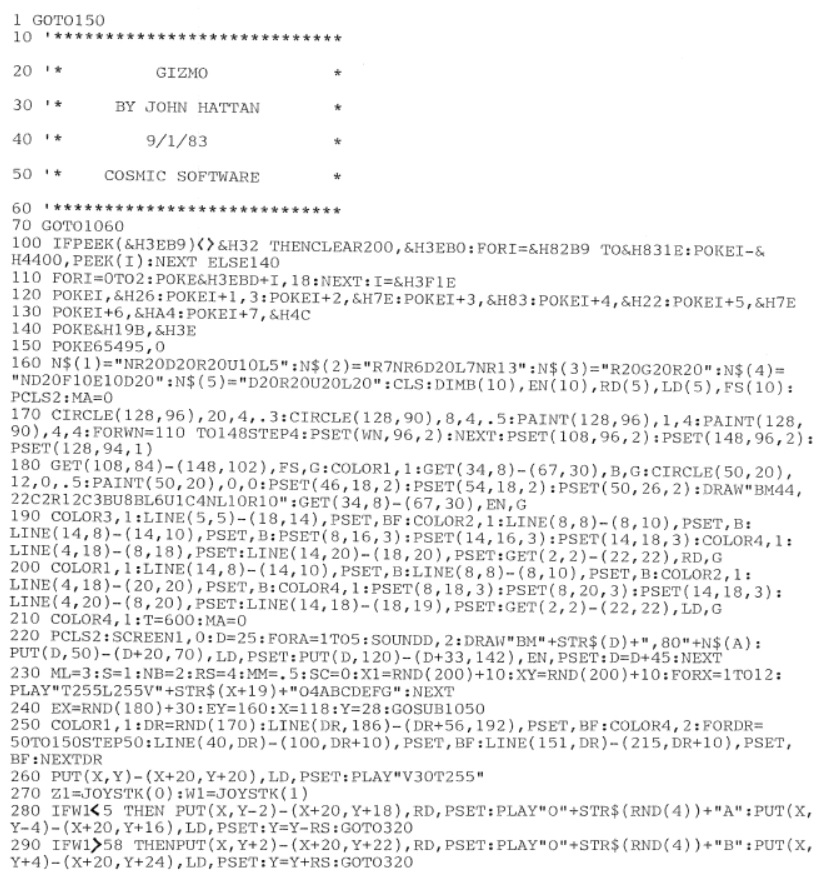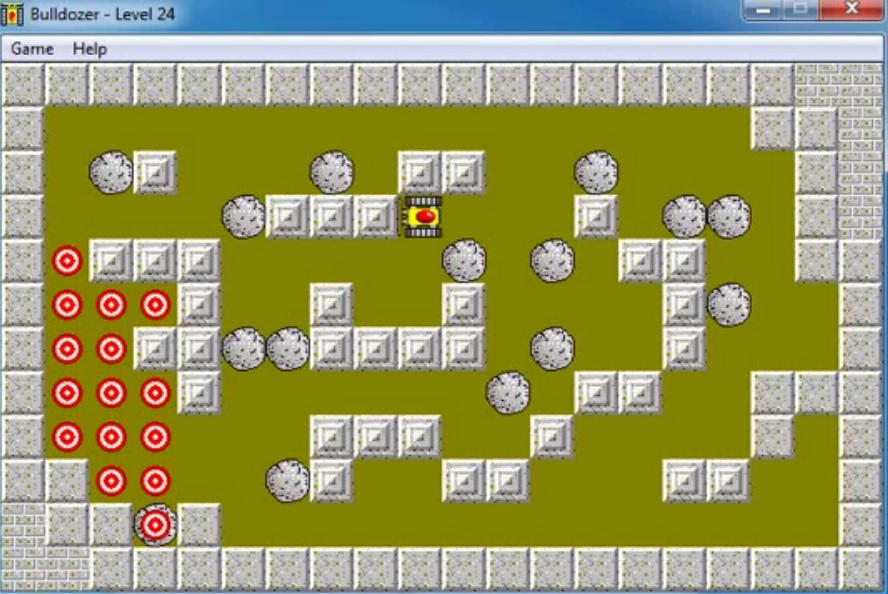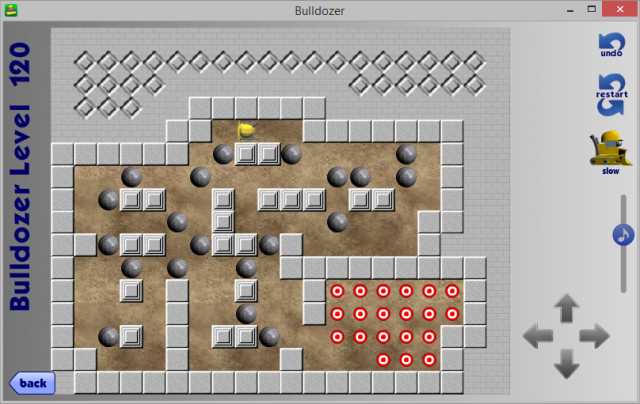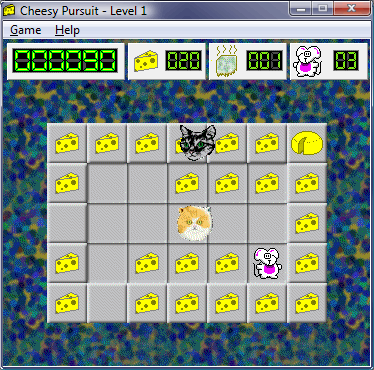Next on my list? A guy who made a very addictive puzzle game that was one of the first PC games for me to play; Bulldozer. I actually had to grab an old computer out of storage and fire up the “24 Games Collection” to find out its original creator, a company by the name of “The Code Zone”.
After finding out that they’re very much alive, I was able to get in contact with them and with John Hattan. Turns out, he was the guy who made the whole “24 Games” collection, including Bulldozer. And interesting enough, this was one of the more interesting interviews I’ve done so far.

Tell me a bit about yourself. How did you get into game development?
Oh, it’s the typical story. I was the nerdy high school kid with the TRS-80 who was trying to make it do something interesting. And when you’re in high school, computer games are the only thing that’s interesting. With the amount of game-depth you could get from 16k of memory and a 0.8Mhz processor, you find that the real challenge isn’t in playing the game but in making one.
I actually found the source code to my first game a while back and scanned it. Best part is that I had to go in and manually draw in the greater-than and less-than characters because my old Smith-Corona daisy wheel printer couldn’t print those characters.
John gave me a PDF with a snippet of his code for a game called Gizmo. You can see below (click to enlarge):
I got into it professionally right after college. I graduated from Texas A&M and ended up in Fort Worth working for Radio Shack’s software division. That was the era when you were expected to bundle some kind of productivity suite with your computer, and ours was this pre-Windows thing called DeskMate. I maintained a couple of DeskMate games as well as a few other pieces of the system.
In the early 1990’s, I was writing games at night while my wife was attending college classes. This was the era when Minesweeper was popular, and discount publishers were looking for similar stuff. I wrote and sold a few little card and puzzle games to publishers, but they never got them onto the shelves. Between writing new games and getting the rights back to games that never shipped, I ended up with 21 little board and card and puzzle games.
I contacted Expert Software (a popular maker of discount CD-ROM games). It just so happened that the current discount-rack bestseller was a collection of 24 games from another publisher, and they wanted something similar. They said we’d have a deal if I could sell them a 24-game pack with an installer and a cute menu that described all the games. So I quickly wrote three more games, and “24 Games For Windows 95” was born. Bulldozer was around game number 18 in the collection.
As for Bulldozer itself, the concept isn’t original. There was a Japanese game called “Soko Ban” which was based on an even older character-based terminal game. “Soko Ban” had a few small free implementations for Windows, but they were’t very good. I really liked the concept of the game, so I decided I could make a better one.
Until you had mentioned it, I had no idea there were printer with daisy flywheels. That’s interesting! The oldest printer I recall was a dot-matrix Panasonic KPX-1180.
How did writing games on your own work out for you? Was this a work-at-home sort of deal?
Yeah, daisy wheel printers were cool for a while. They wouldn’t do graphics, but the text quality was really good compared to the awful dot-matrix printers you could get back then.
Yeah, it was totally a spare-time project. The day-job code writing on DeskMate wasn’t very fulfilling, and it seemed like there were far cooler things to write, so I started writing code at home. Microsoft Windows was in the process of replacing MS-DOS as the market-leader around then, and lots of cool programmer stuff was coming out that I wanted to try.
I hear you on that part of “wanting to code something cool” part. In one of my intro computer science classes, I had written a command prompt Java program that would calculate how long it’d take a, anti-orbital railgun to fire at an orbital target. Not as much as fulfilling to make a game, heh.
I first heard about Bulldozer from an old PC that my parents had gotten in 1999. How did that game’s development and concept come about?
The Bulldozer theme took a little thought. I didn’t want the game to be abstract (red dots pushing blue dots), so I made a list of “things that push other things”. Some of the existing implementations had a little factory worker who pushed boxes. But that theme was frustrating because it was never explained why a person could only push boxes and not pull them.
I eventually settled on a Bulldozer pushing big round rocks. Bulldozers have a great big pusher on the front and no obvious way to pull something, so it seemed like a good fit.
I knew the concept was sound when I let my 75 year-old grandmother play the game at a family reunion. With no scoring and no time-limit, she thought the game was a waste of time. Then she pushed a rock into a corner, realized that the rock was now irretrievably stuck, and had the “aha” moment that there’s actually some strategy there.
So that’s how Bulldozer came about. Interesting insight!
I remember that ever four levels there was a password. If you could only get to the second or third level and not beat it to hit then next “point”, my cousin and I would pull gymnastics such as leave the computer on the entire night or even draw the solutions out on paper. The passwords to resume was on the level of a sacred thing.
Was this an intentional design aesthetic? Or a limitation of being unable to implement a save feature?
I actually don’t remember why I went with passwords every four levels rather than passwords every level or save-files. I remember that “Lemmings” was really popular around then, and it gave out passwords every level rather than have a “save your progress” dialog. It worked for Lemmings, so I went with it.
Actually the password scheme rather worked out in my favor. Those old games had a long “shelf life”, and a lot of users ended up reinstalling the game on their new machines. Your progress-file might be long gone, but you probably kept that sticky-note with your level passwords.
The password was a good feature! It gave the game a Megaman/SNES feel, as many of those games would spit out a password to continue. I think it was a great feature as well. I actually was given a diskette (which is now lost) from aforementioned cousin in 2007 with all the Bulldozer passwords. I find it funny with the remark of the post-it note, because that did occur in a different medium!
Were you daunted on how to distribute a product making it by yourself? Or you had some confidence and connections to be able to go to people like Expert Software to attempt to sell your creation? How well did 24 Games fare after it was completed?
This was all pre-WWW, so you had to get your CD-ROM in a box on the shelf in a store. And that either meant you had to find a publisher or convince the stores to sell your stuff directly. I had a friend who was selling a piece of productivity software to the stores, and it was costing him a lot of money and taking a lot of time. Meanwhile the CD-ROM discount racks were dominated by about a half-dozen publishers, which meant that a little one-horse developer like me didn’t have much of a chance.
So one day I did a big marathon visit to my local CompUSA, Computer City, Wal Mart, Staples, and Target, and I wrote down the name and contact info for every publisher that sold stuff similar to mine. I remember there was Expert, Softkey, Cosmi, Masque, and a few others. My wife and I then spent an afternoon playing phone-tag with them until most had mailed or faxed NDA’s and submission guidelines to us.
It actually didn’t require much confidence. The software buyers were pretty friendly with us, because we were giving them exactly what they wanted. We weren’t showing up with a half-finished prototype or a design document of something we planned to make. We had games that were complete and ready to put on the shelf. And when Expert Software played the games and came back to us with a deal, we went with it.
“24 Games For Windows” actually sold quite well. I remember we were on the PC Week software top-10 list a few times. We released a “sequel” called “Arcade Magic” with more games and Bulldozer II. Softkey (Expert’s biggest rival) had a bestselling pack of 40 games, so we folded the packs together and released it as “40 Games for Windows” (even though there were 43 games, and they also ran on Mac). I guess market confusion was more important than accuracy.
We also got a good break because of a minor industry shakeout. Back then, you might remember that there were cheap CD-ROM’s advertising HUNDREDS of games, which were just collections of downloaded shareware. They sold well, but consumers hated ’em — grandma just paid $10 for a CD of games, and as soon as she installed a game, the game would ask them for more money. They got lots of returns, and I think Wal Mart was the first to ban those from its shelves.
Incidentally, that heralded the rise of all those “Deer Hunter” games, as the software discount racks suddenly had a lot of empty space. Credit to those people for cranking out a pile of hunting simulators in a short time 🙂
That’d explain all those hunting games! It seemed that something weird happened game-wise until stuff like Halo and post-2000 era games came out. I actually owned two of those “200+ games” CD’s myself, only to find that 3/4 of the games were demos I could’ve downloaded online for free. Wasn’t too happy about that. That’s a pretty impressive track-record with your games, though. I’m honestly impressed. 🙂
When your games started to sell well, did you quit your day job? Did you pursue writing your own games/programs full-time? If so, what dictated that change?
I quit my day job in 1996. I hadn’t even gotten my first quarterly check, and Expert was already begging me to give ’em another game pack that they could get on the shelves for the holidays. This was around June, and September was the drop-dead date to finish the games, I contracted with a friend in Austin to write a few games of his own, but it clearly wasn’t something I could do part-time.
At the time, I was working at a Mac database component company, porting their components for the up-coming Windows version of the database. Sales of the Windows versions weren’t very good, and the company was on the decline. So leaving that job didn’t cause any tears on either side.
Ultimately my associate and I got twelve games done in eleven weeks. Although that’s not as herculean as it sounds. All the objects I had written for the original 24 games were now really stable and pretty bug-free, so I could concentrate on just writing the game logic. Also since they were mostly board, card, and dice games, I was able to re-use a lot of graphics and sound from previous games.
I’ve noticed that Bulldozer is available on the iPad; how were you able to pull this off if you had Expert sell your game?
Oh, that’s easy. Expert Software died. Around 1997, Expert decided that the real money wasn’t in cheap discount-rack software, but in licensing big-name stuff. So rather than making new cheap game-packs, they made deals with the console guys to bring licensed titles like Sonic The Hedgehog to the CD-ROM discount rack. And it didn’t go well. I don’t know the exact figures, but they went into a lot of debt and were eventually bought by Activision in 1999. Expert still owned the Bicycle Card Games series at the time, and I think that was the only thing that Activision actually wanted to sell. So I was back out on the street.
I sold my games (now numbering about 53) to Cosmi, which sold them as “Top 50 Blazing Windows Games” as well as a couple of other packs. That went on for a few more years, but internet downloads pretty-much wiped them out too.
Downloadable App Stores were around for things like the old Nokia phones, but they were a mess. It wasn’t until the iPhone that app stores finally got a following, eventually making shelf-publishers obsolete. So instead of competing with CD-ROMs full of shareware, I’m now competing with apps that make fart noises 🙂
Speaking of noises, my sister was a big fan of the “Cheesy Pursuit” and “Maze Race” games from the 24 Games pack. She especially thought the sounds were hilarious in the latter. What and/or how did you make the mouse yelling sounds?
I’m pretty sure all of the screaming-mice were my voice. I had an old copy of Sound Forge (before Sony bought them) that I would use to mess with sound effects. One day I made a bunch of screaming and eating sounds into my little $2 computer microphone, sped them up 4X, turned the pitch way up, and I liked the effect.
Actually I think it was the sound effects that convinced me to make games about mice. I was making goofy noises that sounded like panicked mice, and I thought making a couple of mouse-themed games would work well with them.
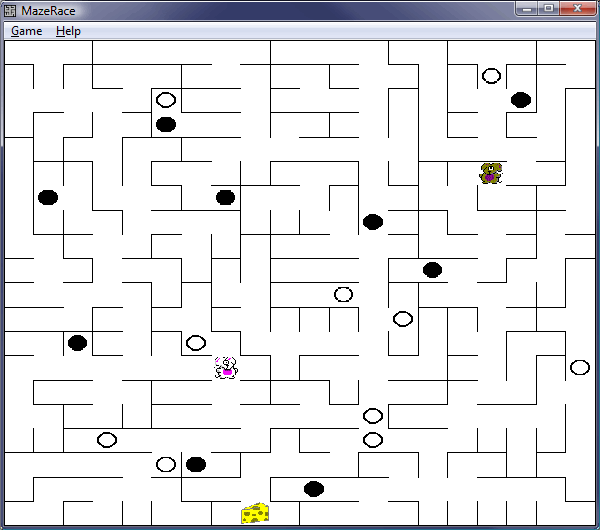
MazeRace, the game in question. Every time a mouse would hit each other or one of the “portals”, a hilarious screech would ensue.
I’ve read articles, seen other developers talk and even spoken to some other game programmers that were doing business back then. Many of these people turned out to be one, two or even three man operations out of a house, often carrying a software name (like EnQue Software) that seemed like an official business. Even a cult status company like iD Software (Doom) started out with three guys living in an apartment in Wisconsin. Does this surprise you?
I am pretty impressed with what ID was able to do with such a small team. I mean, nowadays you could knock out a clone of Doom in a couple of weeks with Unity3D. But making something like Wolfenstein or Doom circa 1990 was quite a feat. As I recall, they had a NeXT workstation that they were using to cross-compile because the NeXT had decent development tools. I would imagine making an engine that could run reasonably while simultaneously making levels, graphics, and sound that were high quality but could still run on a cheap MS-DOS PC was an impressive undertaking.
Development tools today are just so buttery smooth compared to what was out there 20 years ago. I remember how excited I was about Visual C++ 6.0 Professional. That thing was just paradise compared to the hacked together build tools I was using up to that point.
My old interaction principles teacher would make the statement that “you need to game or play games to be able to make games”. Did you play or participate in computer gaming at the time? Do you think this should be so?
Oh yeah, I still play plenty of games. And most of the stuff I play is still the small-scope stuff. I still keep an old VM of Windows XP on my machine just so I can run some old 16-bit games that no longer work on 64-bit Windows. I also really like some of the old classic games that have gotten modern updates. Like that “Microsoft Treasure Hunt”. It’s the same mechanism as Minesweeper, but it’s now got a cave-adventure theme.
And my wife’s completely hooked on Candy Crush and Adventure Xpress, although she still returns to “Zombie Kitten 2”, which is a mobile game I released a couple of years ago.
According to your site and one of your answers, you still make games in this modern day and age. What did it take to adapt to a changing industry?
Most of my stuff doesn’t need to adapt. Think about board games. You can go to your local game store and pick up some truly elaborate new games that will soak up all of your time and money. But you can also pick up a deck of cards and play a game of Gin Rummy. Casual games like Gin Rummy wax and wane in popularity, but they never really go away. They’re not as sexy as that huge new Star Wars space-battle game, but they never go away.
You do need to keep up on the technology, though. The fact that my original CD-ROM games are still playable on modern computers is more due to the longevity of Windows than the portability of my code.
What is your daily lifestyle like a developer now? Do you still run “The Code Zone” as a self-employed business?
I do still run The Code Zone, but it’s more of a part-time enterprise now. I sell games from time to time on my website, but pretty-much everything is handled by Amazon/Google/Apple nowadays. I am still coming up with some new games, hopefully by the end of the year. Right now I’m wading through Unity3D, which is the latest sexy new development tool that all the cool game-developers are using. It’s a very good tool, but it’s far from simple, so I have plenty of learning to do still.
I also noticed that you have apps in several markets, including the Google Play and Apple store. Between the two, which do you find easier to work with? Do you prefer one over the other?
Google Play and the Apple Store have two very different philosophies. The Apple Store was designed to be a hand-curated collection of high quality apps for your phone. Unfortunately the enormous popularity of iPhones pretty-much killed all hope of that, thus both stores are now about 95% junk. Still, Apple does have its infamous “content police” who look at and approve of your game before it will be allowed into the store, which helps a little.
In truth, I’ve never had trouble with Apple’s content police. My stuff is all pretty G-rated, so the games themselves have never raised any eyebrows. Apple is more on the lookout for violations of their own IP, like apps that pretend to be the built-in iPhone apps or apps that step on its revenue model for books/music/in–app-purchases/etc. The only times I’ve ever had an app sent back to me, it was because of something technical. Inevitably there’s some internal file or version number that I forgot to update, and some content-cop at Apple sends me an email telling me to fix it. No big deal.
Google Play is sort of the opposite. When I submit a game to the Google Play store, it appears in the store a couple of hours later, and no human eyes have seen it. If someone notices that an app is breaking their terms, people can lodge a complaint and someone at Google will look at it. This is good in that it’s really simple to get an app listed in the store. It’s bad in that it’s fairly simple to upload something troublesome, and it’ll stay up for a while.
Google Play also has a nice “beta” program. You can build your listing and upload your app, but then not list it. You can then privately invite people to play your game. And once you’re satisfied that it’s working nicely, you can release it to the world.
As far as “ease of us” goes, Google Play gets the nod again. Submitting something to Apple is an odd multi-step process of creating your listing, then using an application (that only works on a Mac) to actually upload your game, and then going back to the listing and submitting it. With Google, you just upload your APK file right from their listing-page.
Speaking of puzzle games, what is your opinion on the huge hit The Witness?
To be honest, I haven’t played it. I’ve been buying Steam games on Humble Bundle, and I’m about a hundred games behind the curve now. I think the last adventure I played to completion (or near-completion, I forget) was VVVVVV. I liked it because, unlike Super Meat Boy, it was designed so an ordinary human like me could have fun with it without dying a billion times.
Aside from learning Unity, what are you working on now? Any new exciting projects to look forward to in the near future?
Actually I’ve got some ideas for Bulldozer-ish stuff. I have a small prototype called “BowlerBall” which is a takeoff on that dopey old 1970’s “Rollerball” movie, but with warring nations solving their problems by strategic bowling puzzles. Yeah, that’s a bit strange. I’m still working on the theme.
I also have another Bulldozer on the burner. This one will have a full level-editor built in and will allow people to share and rate levels and play lots more levels. Also I’m thinking of adding a “Horse” mode where players can go back and forth challenging themselves to homemade puzzles.
Lastly, do you have a favorite food, movie and book? 🙂
Food is easy. Pizza. Pizza is the most amazing thing ever invented.
Okay, maybe the wheel is the most amazing thing ever invented. But the wheel was invented just so it would be easier to deliver pizza.
And I’m one of those hipster weirdos who has seen “The Big Lebowski” and read “A Confederacy Of Dunces” several times. They’re actually quite similar in theme, with an only-somewhat-likable protagonist wandering through situations not really understanding reality but somehow crafting around himself a reality where it all makes sense to him.
That actually might be a good game idea. You’re a character in a complex world who covers it up with a simplified veneer and lives in that.
Yeah, maybe too deep for a game.
And in closing, how can people find you and the projects you’re doing?
Best place is on Google+. Yes, Google+ is a ghost-town, but it is a gentle and encouraging ghost-town. I post stuff there all the time. I’m at https://plus.google.com/u/0/+JohnHattan
I’m also on Twitter and Facebook, but those accounts are really, really boring. You don’t want to follow me there.
If anyone wants to buy a game, I have links to all the app-stores and Amazon and such at www.thecodezone.com
Since I’m a one-man shop, I need to vent my anger. And I do it with an occasionally-updated webcomic at www.angriestprogrammer.com
And finally, if you have kids and you want them to annoy you endlessly with knock-knock jokes, I have a big compendium at www.knockville.com
—
And that does Week 2’s interview. Sorry for taking so long, John. 🙂

